New CCNA – RSTP
Note: If you are not sure about Rapid Spanning Tree Protocol, please read our Rapid Spanning Tree Protocol RSTP Tutorial.
Question 1
Which three statements about RSTP are true? (Choose three)
A. RSTP significantly reduces topology reconvening time after a link failure.
B. RSTP expands the STP port roles by adding the alternate and backup roles.
C. RSTP port states are blocking, discarding, learning, or forwarding.
D. RSTP provides a faster transition to the forwarding state on point-to-point links than STP does.
E. RSTP also uses the STP proposal-agreement sequence.
F. RSTP uses the same timer-based process as STP on point-to-point links.
Answer: A B D
Question 2
Refer to the exhibit:
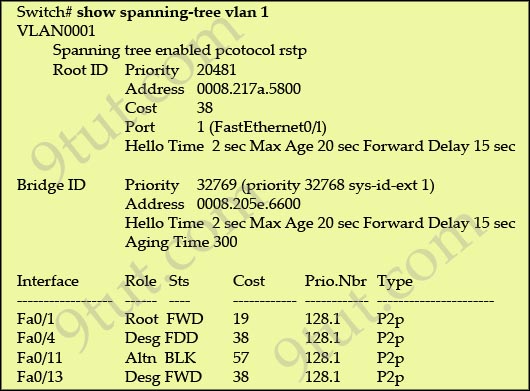
Why has this switch not been elected the root bridge for VLAN1?
A. It has more than one internee that is connected to the root network segment.
B. It is running RSTP while the elected root bridge is running 802.1d spanning tree.
C. It has a higher MAC address than the elected root bridge.
D. It has a higher bridge ID than the elected root bridge.
Answer: D
Explanation
As we can see from the output above, the priority of the root bridge is 20481 while that of the local bridge is 32769.
Question 3
Which command enables RSTP on a switch?
A. spanning-tree mode rapid-pvst
B. spanning-tree uplinkfast
C. spanning-tree backbonefast
D. spanning-tree mode mst
Answer: A
Question 4
Refer to the exhibit. Which statement is true?
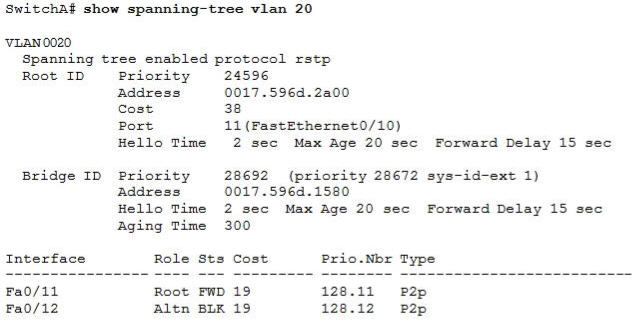
A. The Fa0/11 role confirms that SwitchA is the root bridge for VLAN 20.
B. VLAN 20 is running the Per VLAN Spanning Tree Protocol.
C. The MAC address of the root bridge is 0017.596d.1580.
D. SwitchA is not the root bridge, because not all of the interface roles are designated.
Answer: D
Explanation
Only non-root bridge can have root port. Fa0/11 is the root port so we can confirm this switch is not the root bridge -> A is not correct.
From the output we learn this switch is running Rapid STP, not PVST -> B is not correct.
0017.596d.1580 is the MAC address of this switch, not of the root bridge. The MAC address of the root bridge is 0017.596d.2a00 -> C is not correct.
All of the interface roles of the root bridge are designated. SwitchA has one Root port and 1 Alternative port so it is not the root bridge -> D is correct.
Question 5
Refer to the exhibit. The output that is shown is generated at a switch. Which three of these statements are true? (Choose three)
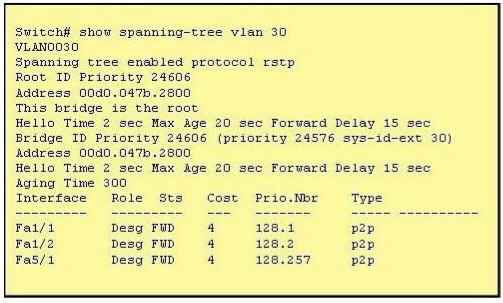
A. All ports will be in a state of discarding, learning or forwarding.
B. Thirty VLANs have been configured on this switch.
C. The bridge priority is lower than the default value for spanning tree.
D. All interfaces that are shown are on shared media.
E. All designated ports are in a forwarding state.
F. The switch must be the root bridge for all VLANs on this switch.
Answer: A C E
Explanation
From the output, we see that all ports are in Designated role (forwarding state) -> A and E are correct.
The command “show spanning-tree vlan 30″ only shows us information about VLAN 30. We don’t know how many VLAN exists in this switch -> B is not correct.
The bridge priority of this switch is 24606 which is lower than the default value bridge priority 32768 -> C is correct.
All three interfaces on this switch have the connection type “p2p”, which means Point-to-point environment – not a shared media -> D is not correct.
The only thing we can specify is this switch is the root bridge for VLAN 3o but we can not guarantee it is also the root bridge for other VLANs -> F is not correct.
Question 6
Which two states are the port states when RSTP has converged? (choose two)
A. blocking
B. learning
C. disabled
D. forwarding
E. listening
Answer: A D
Explanation
RSTP only has 3 port states that are discarding, learning and forwarding. When RSTP has converged there are only 2 port states left: discarding and forwarding but the answers don’t mention about discarding state so blocking state (answer A) may be considered the best alternative answer.
Question 7
Which two of these statements regarding RSTP are correct? (Choose two)
A. RSTP cannot operate with PVST+.
B. RSTP defines new port roles.
C. RSTP defines no new port states.
D. RSTP is a proprietary implementation of IEEE 802.1D STP.
E. RSTP is compatible with the original IEEE 802.1D STP.
Answer: B E
Question 8
Refer to the exhibit. Each of these four switches has been configured with a hostname, as well as being configured to run RSTP. No other configuration changes have been made. Which three of these show the correct RSTP port roles for the indicated switches and interfaces? (Choose three)
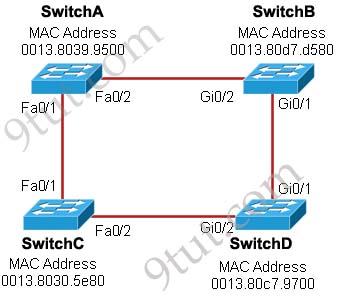
A. SwitchA, Fa0/2, designated
B. SwitchA, Fa0/1, root
C. SwitchB, Gi0/2, root
D. SwitchB, Gi0/1, designated
E. SwitchC, Fa0/2, root
F. SwitchD, Gi0/2, root
Answer: A B F
Explanation
The question says “no other configuration changes have been made” so we can understand these switches have the same bridge priority. Switch C has lowest MAC address so it will become root bridge and 2 of its ports (Fa0/1 & Fa0/2) will be designated ports -> E is incorrect.
Because SwitchC is the root bridge so the 2 ports nearest SwitchC on SwitchA (Fa0/1) and SwitchD (Gi0/2) will be root ports -> B and F are correct.
Now we come to the most difficult part of this question: SwitchB must have a root port so which port will it choose? To answer this question we need to know about STP cost and port cost.
In general, “cost” is calculated based on bandwidth of the link. The higher the bandwidth on a link, the lower the value of its cost. Below are the cost values you should memorize:
| Link speed | Cost |
| 10Mbps | 100 |
| 100Mbps | 19 |
| 1 Gbps | 4 |
SwitchB will choose the interface with lower cost to the root bridge as the root port so we must calculate the cost on interface Gi0/1 & Gi0/2 of SwitchB to the root bridge. This can be calculated from the “cost to the root bridge” of each switch because a switch always advertises its cost to the root bridge in its BPDU. The receiving switch will add its local port cost value to the cost in the BPDU.
One more thing to notice is that a root bridge always advertises the cost to the root bridge (itself) with an initial value of 0.
Now let’s have a look at the topology again
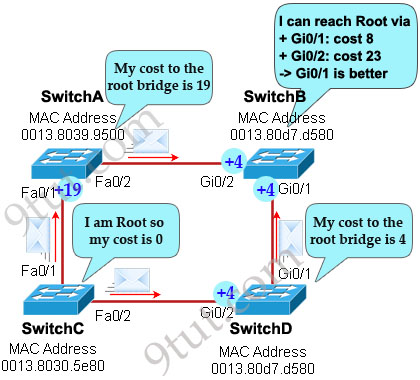
SwitchC advertises its cost to the root bridge with a value of 0. Switch D adds 4 (the cost value of 1Gbps link) and advertises this value (4) to SwitchB. SwitchB adds another 4 and learns that it can reach SwitchC via Gi0/1 port with a total cost of 8. The same process happens for SwitchA and SwitchB learns that it can reach SwitchC via Gi0/2 with a total cost of 23 -> Switch B chooses Gi0/1 as its root port -> D is not correct.
Now our last task is to identify the port roles of the ports between SwitchA & SwitchB. It is rather easy as the MAC address of SwitchA is lower than that of SwitchB so Fa0/2 of SwitchA will be designated port while Gi0/2 of SwitchB will be alternative port -> A is correct but C is not correct.
Below summaries all the port roles of these switches:

+ DP: Designated Port (forwarding state)
+ RP: Root Port (forwarding state)
+ AP: Alternative Port (blocking state)
Question 9
Refer to the exhibit. At the end of an RSTP election process, which access layer switch port will assume the discarding role?
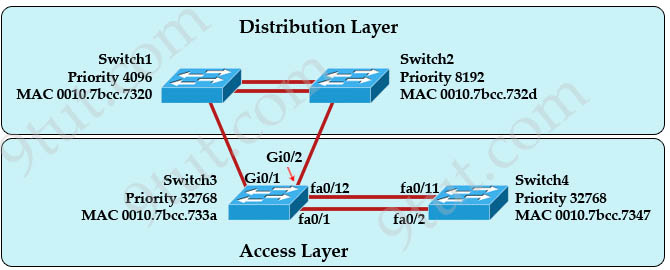
A. Switch3, port fa0/1
B. Switch3, port fa0/12
C. Switch4, port fa0/11
D. Switch4, port fa0/2
E. Switch3, port Gi0/1
Answer: C
Explanation
In this question, we only care about the Access Layer switches (Switch3 & 4). Switch 3 has a lower bridge ID than Switch 4 (because the MAC of Switch3 is smaller than that of Switch4) so both ports of Switch3 will be in forwarding state. The alternative port will surely belong to Switch4.
Switch4 will need to block one of its ports to avoid a bridging loop between the two switches. But how does Switch4 select its blocked port? Well, the answer is based on the BPDUs it receives from Switch3. A BPDU is superior than another if it has:
1. A lower Root Bridge ID
2. A lower path cost to the Root
3. A lower Sending Bridge ID
4. A lower Sending Port ID
These four parameters are examined in order. In this specific case, all the BPDUs sent by Sswitch3 have the same Root Bridge ID, the same path cost to the Root and the same Sending Bridge ID. The only parameter left to select the best one is the Sending Port ID (Port ID = port priority + port index). In this case the port priorities are equal because they use the default value, so Switch4 will compare port index values, which are unique to each port on the switch, and because Fa0/12 is inferior to Fa0/1, Switch4 will select the port connected with Fa0/1 (of Switch3) as its root port and block the other port -> Port fa0/11 of Switch4 will be blocked (discarding role).
If you are still not sure about this question, please read my RSTP tutorial.



@Admin: For Q6->
I think the answer is: BD
From CCNA Academy:
-Discarding:This state is seen in both a stable active topology and during topology synchronization and changes.
-Learning:This state is seen in both a stable active topology and during topology synchronization and changes.
-Forwarding:This state is seen only in stable active topologies.
So There’s no blocking state in RSTP,, and the learning state can be seen in a stable network.
@Anup, Q6 is tricky. In Cisco CCNA Official Cert guide, it has a table that says Learning is an INTERIM state, and that Forwarding and Discarding are STABLE states.
Also, it says the following “You might think that after you configure a switch to use RSTP rather than STP, instead of seeing ports in a blocking state, you would now see the discarding state. However, the Cisco Catalyst switch output basically ignores the new term discarding, continuing to use the old term blocking instead.”
So I think that 9tut answer and explanation is correct.
Question 5 was in the exam recently
passed today, in exam Question 6 was –
A. discarding
B. learning
C. disabled
D. forwarding
E. listening
answer: A,D
Hello everybody
I have a problem with question 8
For me, the designated port on the segment between switches A and B should be the interface Gi0/2 of switch B, because switch B advertises a BPDU with a cost of 8 while switch 1 advertises a BPDU with a cost of 19 on that segment. So the Bridge IDs shouldn’t be taken into account since we have a difference in the adervtised costs.
Could someone explain to me why we use the BIDs in this case?
Thanks !!
Question 8 corect computations:
SwitchC advertises its cost to the other bridges(SwitchA and SwitchD) with a value of 0. Switch D adds 19 (the cost value of curent speed between Gi0/2 on SwitchD and Fa0/2 on SwitchC, speed is 100Mbps ) and advertises this value (19) to SwitchB. SwitchB adds another 4 and learns that it can reach SwitchC via Gi0/1 port with a total cost of 23. The same process happens for SwitchA and SwitchB learns that it can reach SwitchC via Gi0/2 with a total cost of 38(19+the cost value of curent speed between Gi0/2 on SwitchB and Fa0/2 on SwitchA, speed is 100Mbps) -> Switch B chooses Gi0/1 as its root port -> D is not correct.
Hi all,
As Meije, i do not understand why SwitchB Gi0/2 is in blockng state.
Could someone explain why, please ?
Passed Marks: 975, 99.8% from 9tut no need to exert effort for latest dumps. Labs EIGRP, ACL Sim 1 & 2, practice all modifications coz it was given on random. 9tut is enough to pass the exam. GoodLuck. .
Hello MC
You say :
” Switch D adds 19 (the cost value of curent speed between Gi0/2 on SwitchD and Fa0/2 on SwitchC, speed is 100Mbps ) and advertises this value (19) to SwitchB”
But according to the explanations given by the author of the tuto, switch D advertises a cost of 4 to switch B…
So what is the cost advertised by switch D to switch B?
Does it advertise a cost of 4, witch is the cost of it’s Gig interface connected to switch C ? Or a cost of 19 corresponding to the current speed between switches C and D ?
Thanks to all
Thank you !
Hi all,
If you study hard this website, you will pass it for sure. You don’t really need to have the latest dumps. Everything asked in my exam was from 9tut, I didn’t have new questions. The trick is just to know everything from this website: Lab Sim and Questions and you will have it. Trust me ! I agree with Des†rosiers.
Best for all
Q4 & Q8 in 5th Sep 2014 exam
I think that in q9 the answer is correct, but for me switch3 is not the root bridge. I think that the RSPT is calculated on all four switch than Switch1 is the root bridge because the lower priority. Relatively to the switch on the access layer, i should say that switch3 has better BPDU then Switch4 then surely one on the port of Switch4 they will go in discarding Which? f0/11 or f0/2?
f0/11 will go in discarding because the sending port index is f0/12 then is greater then f0/1 that is the sending port-index of f0/2
I have one question regarding the Question 8 – Why Switch D adds 4 to the BPDU coming from Switch C ? OK, it is connected to switch C with gigabit interface, but the other end (Switch C fa0/1 interface) of that link is fa0/1 and the link speed(bandwidth) will be 100 Mbps after negotiation between to ports, so why does it matter that Switch D is connected with gigabit interface, if it still work with 100 Mbps (fast ethernet) speed?
Sorry, I meant fa0/2 interface on switch C
Passed today with 958
Q3 and Q6 was on test
thanx 9tut
I agree with gio and tested it out on real switches. They advertised 19 as the cost from a Gi to a FA port because it runs 100mbps. They did not adv 4
What is the difference between AP-Alternate Port and Backup Port?
why the backup port need to be connected to hub. please any one explain
as i know, altenate port is the port that saves as the backup for the root port when there happen the root port link failure on non-root bridge altenate port takes over as the root port
now comes to back up port, this one saves as the back up for designeted port on the network segment, as we know each network segment need to have one designeted port to connect to root. so when this designeted port fails on that network segment themn back up port takes over as designeted port
Q5: The only thing we can specify is this switch is the root bridge for VLAN 3o but we can not guarantee it is also the root bridge for other VLANs -> F is not correct.
It is not true, the switch is running with RSTP and not MSTP so it is root for all vlan!!
Question 9
Refer to the exhibit. At the end of an RSTP election process, which access layer switch port will assume the discarding role?
the question is WRITE wrong! DISCARDING IS NOT A ROLE but A STATE! anyway the answer is OK
Hi people there are new Labs en ccna exam, Oone about ospf and point to point, are really really easy , I tell you for you know it. A few days I gonna up this scenarios
I’m very confused about Q8, could somebody please help me?
In Todd Lammle’s book it says: “Even though the root bridge (SC) has a Gigabit Ethernet port, it’s running at 100 Mbps because SA’s port is a 100-Mbps port, giving it a cost of 19. If the paths between SA and SC were both Gigabit Ethernet, their costs would only be 4, but because they’re running 100 Mbps links instead, the cost jumps to a whopping 19!”
Then why would path cost for SwitchB Gi0/1 in Q8 be 8? It should be 23 because link SwitchC-SwitchD runs only 100Mbps with cost 19, isn’t it?
*link cost for SwitchB Gi0/1, sorry
The answer for Q8 is still correct, but the cost path in the schematic is wrong.
SwitchB’s shortest path to the root will be B>D>C but the cost of that route is 23 (not 8), compared to the B>A>C which would be 38 (not 23). Cost is calculated on the negotiated port speed, not maximum.
Therefore SwitchD’s cost to the root is 19, not 4.
Just set this up in a lab so I’m pretty sure I’m right :)
Greg, et al:
The original question doesn’t mention port cost, so I assumed that port cost is the same in either direction from Switch B. If all links are 100Mb, the cost should be the same in each direction, because Switch A and Switch D would only add 4 to the cost towards B.
Please someone help me understand.
Thanks
It doesn’t mention cost but you need to take cost into account because it’s used by STP to determine the path to the root. The ports are labelled as either ‘Fa’ or ‘Gi’.
Gi port Gi port = gigabit link = cost 4
Fa port Fa port = 100Mbps link = cost 19
Gi port Fa port = 100Mbps link = cost 19
Therefore, switch A and switch D will add 19 to the cost they receive. Switch B will add 4 to the route from D and 19 to the route from A.
Hope that makes sense.
Greg;
Thanks; you are absolutely correct. I did overlook the labels, and assumed everything was 100Mb.
Thanks again.
Q6 the correct answer is B and D because RSTP don’t have the blocking state it has discarding,learning and forwading.
For Q9, will Gi0/2 of Switch 3 assume the discarding role?
Greg,
About Q6; I see your point, but STP’s “DISABLED, BLOCKING and LISTENING” have been merged into one RSTP port state (DISCARDING). However, since the question does not have DISCARDING in it, the closest to it could be either “BLOCKING or LISTENING” and FORWARDING. Which is AD or DE, but I would choose AD, since by definition, BLOCKING is closer to DISCARDING than LISTENING.
q9 today
I think that explanation of Q8 is wrong. Links between Fast and Giga interfaces has cost 19, not 4. This is the only explanation for Gi 0/2 be blocked. If were 4, the cost between SWC and SWA will be 12, trought SWD e SWB. Gi 0/2 will never be blocked.
In my opinion, explanation is wrong.
Q 5,6,7,8,9 and 10 on 10th Nov
Can someone send me the latest dumbs for CCNA to albertomch13@gmail.com,
Thanks,
Q 9 Today 24-Nov
Q5 yesterday
Q8 Explanation:
SwitchA (Fa0/2) will be designated port, because he have lower path cost to the Root (19). SwitchB (Gi0/2) will be alternative port, because he have higher path cost to the Root (23) = 19 (link C-D)+4 (linl D-B). Path cost to the Root more important then Sending Bridge ID.
Q9: does not exist – A lower Root Bridge ID (Root ID only one, and maybe it repeat: 2. A lower Sending Bridge ID). Must be:
1. A lower path cost to the Root
2. A lower Sending Bridge ID
3. A lower Sending Port ID
Hello,
Regarding Question 8.
Ilya,
-you confirm that the costs on the example are wrong (basically, we need to take into account both speed ends of the link and get the minimum (Bridge C-F0/2=100Mbps and BridgeD-G0/2=1Gbps Cost = 19 ) Correct?
-You confirm that when deciding Designated port for a Segment first thing to check is Path Cost from Sending Bridge and not the Sending ID Bridge. (Basically, same thing as when )
and that is why SwithAF0/2 is Designated. Correct?
Thanks a lot.
Q3,6,7 today
Hello,
One note about Q.8. based on the given diagram there are only two correct answers (B and F).
I also simulated the diagram and here what I found:
1 – the answer is A, B and F in case of all ports have equal cost.
2 – the answer is B and F if the ports costs as shown in the exhibit.Why?
SwitchA F0/2 -> Altn
SwitchB G0/2 -> Desg
SwitchB G0/1 -> Root
!! some dumps has incorrect answers to some questions. so don’t depend on the dumps 100% for your answer >> I know its a good source of information just be careful.
All the best
Q4, 8 Today, 1/12/14
Greg, good explanation on Question 8. The following statement by the author of this page is absolutely false: “Now our last task is to identify the port roles of the ports between SwitchA & SwitchB. It is rather easy as the MAC address of SwitchA is lower than that of SwitchB so Fa0/2 of SwitchA will be designated port while Gi0/2 of SwitchB will be alternative port”
The MAC of Switch A has nothing to do with its Fa0/2 port being designated. The fact that Switch A’s Fa0/2 port has a lower cost to the root bridge (Switch C) is the reason it is designated for the A — B segment.
Hello Everyone,
I am preparing myself for CCNA 200-120 vendor exam.
It would be grateful to me if any one can send the latest dumps & questions to my mail ID:nomanbgc@gmail.com
Thanks
Noman
Alhamdulillah . I passed today 972/1000. Q4 & Q8 in my exam today .thankx to allah then 9tut
It seem Q6 is controversial to some people.
The trick here is the statement “after RSTP has converged”
There are only two possible states after it’s converged. FW or BLK.
Q8 answers are correct.
The explanation is actually wrong.
What has to be taken into account is the port speed and not the port media on Switches B and D. Once you connect a Gigabit port on a Fast port the speed will be 100Mbps and therefore, the STP will calculate as 19. Switch B has 4 via Switch D and 19 via Switch B, that’s why it will block port G0/2 and keep G0/1 as root. Therefore switch A port F0/2 and switch D port G0/1 will be Designated. The only answer available is “A” Switch A port F0/2, designated.
Q1. passed
Q8 I am a little bit confused. Why is G0/1 on switch B root port?
Q4, 8 today
passed, thanks to 9tut